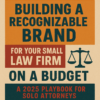Hey Solos and Friends!
Whether you’re a seasoned pro or just dipping your quill into the ink, the following 25 tips will help you tackle legal copywriting with finesse, sophistication, and flair.
Understanding the Essence of Legal Copywriting
Legal copywriting isn’t just about crafting words; it’s about wielding language like a scalpel—precise, effective, and without room for misinterpretation. Here’s how you refine your skils:
- Know Your Audience: Understand who will read your legal copy and tailor your language accordingly.
- Clarity is Key: Use plain language to ensure your message is crystal clear.
- Stay Updated: Laws and regulations change—stay informed to avoid pitfalls.
Crafting Compelling Legal Copy
Let’s talk about how to make your legal copy not just compliant but compelling:
- Use Active Voice: It adds clarity and authority to your statements.
- Highlight Benefits: Even legal content can resonate better when it focuses on how it benefits the reader.
- Tell a Story: Narratives can make complex legal concepts more relatable and understandable.
Navigating Legal Terminology
- Define Terms: Clearly explain any legal jargon used to avoid confusion.
- Avoid Ambiguity: Precision is your best friend; ambiguity can lead to legal headaches.
- Use Consistent Terminology: Maintain uniformity in language across all legal documents.
Best Practices for Legal Copywriting
- Proofread Thoroughly: Errors in legal copy can have serious consequences—proofread meticulously.
- Consult Experts: When in doubt, seek advice from legal copywriting professionals.
- Be Ethical: Ensure your copy meets ethical standards; accuracy and honesty are non-negotiable.
Tips for Compliance and Consistency
- Follow Guidelines: Adhere to legal guidelines and industry standards.
- Review and Revise: Regularly update and revise your legal copy to reflect changes in laws or policies.
- Keep it Concise: Legal copy tends to be dense—strive for brevity without sacrificing clarity.
Effective Formatting and Structure
- Use Headings and Subheadings: Organize your content to enhance readability.
- Bullet Points: Lists and bullet points break down information for easier comprehension.
- White Space Matters: Don’t underestimate the power of white space—it makes your content more inviting.
Leveraging Technology
- Use Tools Wisely: Grammar checkers and legal writing software can streamline your process.
- Version Control: Keep track of document versions to avoid confusion.
Enhancing Engagement and Accessibility
- Interactive Elements: Where possible, include interactive elements like links or FAQs.
- Accessibility: Ensure your legal content is accessible to all readers, including those with disabilities.
Building Trust Through Transparency
- Disclosure: Be upfront about terms and conditions—transparency builds trust.
- Privacy Matters: Respect user privacy and data protection laws in all your communications.
Evolving with Feedback
- Feedback Loop: Solicit feedback from legal teams and clients to continuously improve your legal copywriting skills.
Legal copywriting isn’t just about ticking boxes; it’s about fostering understanding and compliance while maintaining a human touch. By mastering these 25 fundamental tips, you’ll not only enhance your legal writing prowess but also contribute to a more informed and empowered audience. Remember, every word counts—especially in the world of legal copywriting!
Happy writing!
Yours in the power of words,
Stacey Mathis





